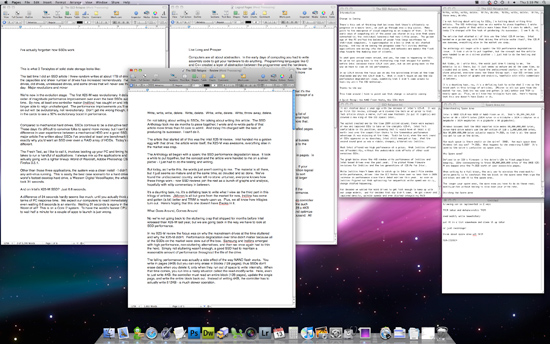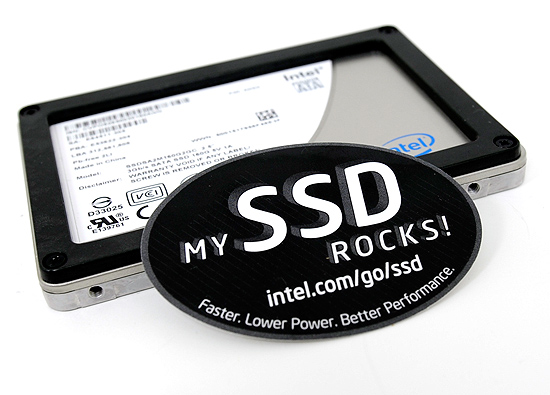Lab Update: The Next SSD Article, Matte vs. Glossy and Touch Screens
by Anand Lal Shimpi on August 21, 2009 4:48 PM EST- Posted in
- Storage
The SSD Relapse
I’ve been teasing everyone on Twitter with this for a while, but I’m really nearing close on the third installment of my SSD coverage. Right now I’m extensively testing TRIM on the major drives. Indilinx is the first out with official TRIM support...at least through a beta firmware. It’s currently enabled on both OCZ and Super Talent drives.

All of the text behind the next SSD article...just wait until you see the Excel sheet to go along with it
There are some limitations to TRIM. Currently the Intel Matrix Storage Manager drivers won’t pass the TRIM command through from Windows 7 to the drive’s controller. If you want TRIM to work at this point you need to use Microsoft’s drivers that come with Windows 7 (note that if you set Intel’s ICH to RAID, Windows 7 loads Intel’s MSM driver so that won’t work).
The benefit of TRIM is huge, your drive doesn’t get slower because of use, it only gets slower as you actually fill it. Intel was very careful/sneaky/shiesty to only enable TRIM on its 34nm drives. Real world performance is actually very similar between the 34nm and 50nm drives for desktop users. What makes the 34nm drive the clear buy is its support for TRIM.

I realize I haven’t said much about the 34nm G2 drives since their announcement, but Intel decided to sample after the announcement so I’ve been busy running these things through the ringer. Intel had to embarrassingly halt shipments of the drive to fix a BIOS password bug that resulted in data loss. I was actually quite surprised that Intel even let this one slip by but they’ve since put tests in place to ensure that it never happens again.
The most impressive advancements really come from the Indilinx camp. Not only has performance improved but Indilinx is actually the first to officially support the ATA8-ACS2 TRIM command. To show you the awesomeness of TRIM I've run a quick test. Here I ran my 4KB Random Write iometer script on a brand new, secure erased Super Talent drive sporting the 1711 TRIM firmware from Indilinx. I then filled the drive (simulating use over time), deleted the partition and benchmarked it again. Note that deleting a partition doesn't seem to trigger TRIM under Windows 7. You'll see that performance drops. Next, I formatted the drive (triggering TRIM) and rebenchmarked:
| SuperTalent UltraDrive GX 1711 | 4KB Random Write IOPS |
| Clean Drive | 13.1 MB/s |
| Used Drive | 6.93 MB/s |
| Used Drive After TRIM | 12.9 MB/s |
Pretty sweet huh? You'd get the same results from the Indilinx Wiper Tool, but this one happens automatically. You get nearly-new performance without doing a thing. TRIM is awesome. The firmware is available from both OCZ and Super Talent but I’d avoid it until it hits final. The Indilinx Wiper Tool is more than sufficient for your TRIMing needs for now.
The WePC Update
I’ve done some writing on a couple of things that have been on my mind lately. The first being Glossy vs. Matte displays on notebooks. It’s something I tackled last year but it’s still a worthwhile topic, especially given the attention Apple is getting. I should mention that Apple has since gone back to offering a Matte display option on its 15-inch MacBook Pros.
The other point of discussion is the future of touch screens outside of smartphones. Apple did a wonderful thing with the iPhone, but now the OEMs are struggling to figure out where touch (and multi-touch) is useful when it comes to notebooks and desktops. Help them figure it out.
Head over to WePC and check it out, leave ASUS/Intel your feedback and you may just see your opinions productized at some point :)
More Ion Cometh
Between the next SSD article and Lynnfield I'll find myself with a bit of time to tackle a look at current (and one upcoming) mini-ITX Ion platforms. My question to you is: is there anything we haven't covered with regards to Ion that you'd like to see in that article?










83 Comments
View All Comments
jimhsu - Saturday, August 22, 2009 - link
PSS And can someone give an explanation why SSDs slow down with more data filled, regardless of TRIM availability? I thought the point of TRIM was to enable the SSD to recognize certain blocks as free, seeing as an SSD that has been written at least once needs to keep track of all its blocks, empty or not. If so, why does it matter if its real data or deleted data?Anand Lal Shimpi - Saturday, August 22, 2009 - link
The Intel SSD treats all unused area as free space. The more free space you have, the lower your write amplification resulting in better performance. As your free space goes away, either by using the drive or by actually filling it with valid data, the frequency of block-cleaning (read modify writes) goes up. Your write amplification goes up, performance goes down.TRIM makes sure that if you're not filling the drive with valid data, that its performance remains as close to new as possible. This is very helpful.
I'll explain this in great detail in the next SSD article :)
Take care,
Anand
MrPoletski - Tuesday, August 25, 2009 - link
Sounds to me like the solution to this issue would be to do background cleaning of the disk. They say you don't need to defrag an SSD... well is that really true?somehow, you've ended up with a usage pattern of the first 4 kb used, the next 4kb free, next 4 used, next 4 free and so on, all the way to the end of the disk. Horribly inefficient storage means and an extreme example of what you disk might end up looking like. It also means that every single overwrite needs to be a read-erase-write.
so what if you had a little engine running in the background that re-organises data on the SSD to free up individual blocks completely, cramming most of the data down into single, fully used, block size chunks.
on top of that, why not have your file system point to TWO places for the same data. So you copied that solo 4kb from one block into a partially populated block filling it completely. Why delete the old data? Instead you could make the disk aware that the data exists in two places and decide which to modify (destroying the other copy) in the event of a overwrite and which to forget about in the event of something else needing the space?
you decide this based on which route would require the most work from the drive.
jimhsu - Sunday, August 23, 2009 - link
Perhaps my question is better rephrased like this:How does the performance of a used X-25M w/o TRIM, with 40GB free space compare to one with TRIM, but with say only 5 GB of free space? From what you say, the 2nd drive should be faster, because (ideally) the number of free blocks for the 2nd drive should be greater than the first. Maybe we can't answer that right now because there is no firmware with TRIM out for Intel, but it's something to think about.
jimhsu - Saturday, August 22, 2009 - link
To be clear: The drive is obviously struggling, because disk queue lengths are high (5-10). This was tested with the Intel Matrix Controller driver.PS Also about the Matrix Controller driver - for some reason on ICH9R, Intel disables NCQ functionality for AHCI on Windows 7. I have not totally confirmed this, but AS SSD 64 thread /4k random read results without Matrix Controller are 3 TIMES higher than with the Matrix Controller.
acolona - Friday, August 21, 2009 - link
I have been waiting on your article to make my decision...any idea on an ETA? seeing all this SSD goodness is killing!I have basically been waiting to see if you have an opinion on an intel G2 vs OCZ vertex vs OCZ vertex turbo.
I mainly use my machine for gaming, and audio/video duty...ripping dvd's, a LOT of video transcoding, and then multitasking for work.
If money didn't matter between these 3 drives, and you had to buy tomorrow, what would you suggest? What is the main tradeoff between an intel and a indilinx drive?
AbRASiON - Wednesday, August 26, 2009 - link
I agree with this ETA request, we're dying here with credit cards waiting.semo - Saturday, August 22, 2009 - link
Intel's main advantage right now is that even without TRIM it performs very well when worn compared to the others. Also, nothing can beat it in random writes at 4kb and it joins other SSDs at saturating SATA2's read bandwidthAnand Lal Shimpi - Saturday, August 22, 2009 - link
Intel vs. Indilinx really boils down to this: random write performance (Intel) vs. sequential write performance (Indilinx).In most single application benchmarks, there's no measurable difference between the two. There are a few cases where the sequential write advantages of Indilinx help a lot, but they seem to be rare (outside of pure sequential writes to the drive).
Ultimately Intel's drives offer lower latency for a random write. You're looking at 0.3 - 0.5ms for Intel vs ~1ms worst case scenario for Indilinx. Both are an order of magnitude faster than a hard drive. Theoretically the Intel drive should "feel" faster in normal use, but that's a tough one to quantify.
Indilinx had gotten so good that I even swapped out my personal X25-M for an OCZ Vertex just to make sure I wasn't recommending something I wasn't comfortable with. The experience has been wonderful; it feels slightly slower but it's difficult to tell if that's real or not. The benchmarks indicate it is but I'm not sure if my experience testing is what is making me hypersensitive to performance or not.
You can't go wrong with either drive. My pick continues to be Intel but the pricing works out in a nice way; simply pick the capacity you want and you'll find the right solution.
If all you need is 60GB, go Indilinx. If you need 80GB, go Intel. 120GB? Indilinx. 160GB? Intel. If price doesn't matter? Intel.
Just stay away from the Samsung based drives.
Take care,
Anand
techvslife - Tuesday, August 25, 2009 - link
Unfortunately, the new 1711 firmware for Indilinx barefoot controller drives is causing massive data corruption on many Windows 7 systems (now discussed on ocz vertex, supertalent, & crucial support forums). The cause currently is thought to be the interaction of TRIM with ACPI on some motherboards.